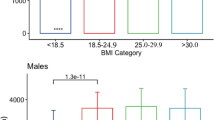Summary
Aerobic fitness and percent body fat were measured in a sample of 438 male Army recruits between the ages of 17 and 30 prior to the commencement of training. The sample came from all areas of England and Wales. Aerobic fitness, as represented by maximal oxygen uptake (\(\dot V\)O2 max), was predicted from the Astrand submaximal bicycle heart rate test. Body fat was predicted from four skinfold measurements. Total group means ±SD were: age, 19.5±2.5 years; \(\dot V\)O2 max 41.7 ±8.3 ml/kg·min; and body fat, 14.5±4.8% of body weight. \(\dot V\)O2 max varied with age, athletic participation and aptitude score. No relationship was found with occupation of parent, prior civilian occupation or smoking severity. When adjusted for methodological differences, \(\dot V\)O2 max was slightly below similar Army entrants in Norway and the United States.
Similar content being viewed by others
References
Astrand, I.: Aerobic work capacity in men and women with special reference to age. Acta Physiol. Scand. 49, Suppl. 169, 45–60 (1960)
Astrand, P.-O., Ryhming, I.: A nomogram for calculation of aerobic capacity (physical fitness) from pulse rate during submaximal work. J. Appl. Physiol. 7, 218–221 (1954)
Astrand, P.-O., Rodahl, K.: Textbook of work physiology. New York: McGraw-Hill 1970
Bailey, D. A., Shephard, R. J., Mirwald, R. L., McBride, G. A.: A current view of Canadian cardiorespiratory fitness. Can. Med. Assoc. J. 111, 25–30 (1974)
Behnke, A. R., Wilmore, J. H.: Evaluation and regulation of body build and composition. Englewood Cliffs: Prentice-Hall 1974
Cotes, J. E., Davies, C. T. M., Edholm, O. G., Healy, M. J. R., Tanner, J. M.: Factors relating to the aerobic capacity of 46 healthy British males and females, ages 18–28 years. Proc. R. Soc. Lond. [Biol.] 174, 91–114 (1969)
Davies, C. T. M.: Limitations to the prediction of maximum oxygen intake from cardiac frequency measurements. J. Appl. Physiol. 24, 700–706 (1968)
Davies, C. T. M.: The oxygen-transporting system in relation to age. Clin. Sci. Mol. Med. 42, 1–13 (1972)
DuBois, D., DuBois, E. F.: A formula to estimate the approximate surface area if height and weight be known. Arch. Int. Med. 17, 863–871 (1916)
Haisman, M. F.: The assessment of body fat content in young men from measurements of body density and skinfold thickness. Human Biol. 42, 679–688 (1970)
Haisman, M. F.: Assessment of the exercise capacity of young men. Ergonomics 14, 449–456 (1971)
Hermansen, L.: The development of work capacity and physical fitness — individual differences. In: Fitness, health and work capacity. Larson, L. O. (ed.). New York: MacMillan 1974
Hermansen, L., Saltin, B.: Oxygen uptake during maximal treadmill and bicycle exercise. J. Appl. Physiol. 26, 31–37 (1969)
Kannel, W. B., Dawher, T. R., Kagan, A., Revotskie, N., Stokes, J.: Factors of risk in the development of coronary heart disease — six year followup experience. The Framingham Study. Ann. Int. Med. 55, 33–50 (1961)
Kannel, W. B., Doyle, J. T., McNamara, P. M., Quickenton, P., Gordon, T.: Precursors of sudden coronay death. Factors related to the incidence of sudden death. Circulation 51, 606–613 (1975)
Knuttgen, H. G.: Physical working capacity and physical performance. Med. Sci. Sports 1, 1–8 (1969)
McArdle, W. D., Magel, J. R.: Physical work capacity and maximum oxygen uptake in treadmill and bicycle exercise. Med. Sci. Sports 2, 118–123 (1970)
Miyamura, M., Honda, Y.: Oxygen intake and cardiac output during maximal treadmill and bicycle exercise. J. Appl. Physiol. 32, 185–188 (1972)
Rowell, L. B., Taylor, H. L., Wang, Y.: Limitations to prediction of maximal oxygen intake. J. Appl. Physiol. 19, 919–927 (1964)
Shephard, R. J.: World standards of cardiorespiratory performance. Arch. Environ. Health 13, 664–672 (1966)
Shephard, R. J., Allen, C., Benade, A. J. S., Davies, C. T. M., Di Prampero, P. E., Hedman, R., Merriman, J. E., Myhre, K., Simmons, R.: The maximum oxygen intake — an international reference standard of cardiorespiratory fitness. Bull. WHO 38, 757–764 (1968)
Siri, W. E.: Body composition from fluid spaces and density: analysis of methods. In: Techniques for measuring body composition. Brozele, J., Henschel, A. (eds.), pp. 223–244. National Academy of Science, Washington, D. C., 1961
Tibblin, G., Wilhelmsen, L., Werko, L.: Risk factors for myocardial infarction and death due to ischemic heart disease and other causes. Am. J. Cardiol. 35, 514–522 (1975)
Vogel, J. A., Ramos, M. U., Patton, J. F.: Comparisons of aerobic power and muscle strength between men and women entering the US Army (Abstract). Med. Sci. Sports 9, 58 (1977)
Author information
Authors and Affiliations
Rights and permissions
About this article
Cite this article
Vogel, J.A., Crowdy, J.P. Aerobic fitness and body fat of young British males entering the army. Europ. J. Appl. Physiol. 40, 73–83 (1979). https://doi.org/10.1007/BF00421153
Accepted:
Issue Date:
DOI: https://doi.org/10.1007/BF00421153




